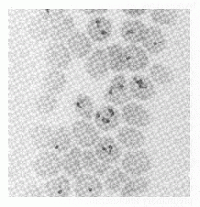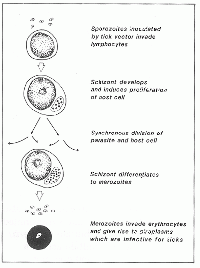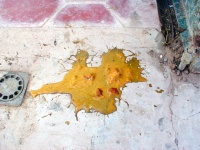Difference between revisions of "Theileriosis - Cattle"
| (26 intermediate revisions by 2 users not shown) | |||
| Line 1: | Line 1: | ||
| − | + | Also Known As — '''''Bovine Theileriosis''''' — '''''[[Theileria]]''''' — '''''Theileria parva''''' — '''''Theileria annulata''''' | |
| − | Also Known As | + | [[File:T_parva.gif|thumb|200px|right|Theileria sp inside erythrocytes of host]] |
| − | + | ==Introduction== | |
| − | |||
| − | + | Theileriosis is a disease of mammals and birds caused by a [[protozoa | '''protozoal''']] pathogen which resides within the [[Lymphocytes - Introduction | lymphocytes]] and [[Macrophages | macrophages]] | |
| − | |||
| − | Theileriosis is a disease of mammals and birds caused by a [[protozoa | '''protozoal''']] pathogen which resides within the [[Lymphocytes - Introduction |lymphocytes]] and [[Macrophages|macrophages]] | ||
| − | + | ''T. parva'' and ''T. annulata'' in cattle and ''T. Lestoguardi'' in sheep are the most economically important in domestic ruminants. | |
| − | + | [[Theileria]] species are closely related to [[Babesia]] parasites. | |
==Signalment== | ==Signalment== | ||
| Line 18: | Line 15: | ||
'''Native animals''' also appear to have a higher degree of '''innate tolerance''' in endemic areas than those that are imported, even if of the same breed. | '''Native animals''' also appear to have a higher degree of '''innate tolerance''' in endemic areas than those that are imported, even if of the same breed. | ||
| − | '''Friesians''' appear particularly susceptible to infection with | + | '''Friesians''' appear particularly susceptible to infection with [[Theileria]] species. |
| − | [[Parturition Endocrine Control - Anatomy & Physiology |Parturition]], [[Lactation - Anatomy & Physiology |lactation]] and stress can make an animal vulnerable to theileriosis, as they can | + | [[Parturition Endocrine Control - Anatomy & Physiology | Parturition]], [[Lactation - Anatomy & Physiology | lactation]] and stress can make an animal vulnerable to theileriosis, as they can any disease. |
Age linked tolerance may make younger calves more tolerant of disease than adults in some areas. | Age linked tolerance may make younger calves more tolerant of disease than adults in some areas. | ||
==Distribution== | ==Distribution== | ||
| − | Distribution of disease depends on the presence of [[Ticks|tick]] vectors and thus is primarily in '''tropical regions'''. Various species of tick are implicated. | + | Distribution of disease depends on the presence of [[Ticks | tick]] vectors and thus is primarily in '''tropical regions'''. Various species of [[Ticks | tick]] are implicated. |
| − | The distribution of | + | The distribution of anaplasmosis is increasing all the time. |
| − | ==Transmission== | + | ==Lifecycle and Transmission== |
[[File:Theileria_lifecycle.gif|thumb|200px|right|Theileria Lifecycle]] | [[File:Theileria_lifecycle.gif|thumb|200px|right|Theileria Lifecycle]] | ||
| − | ''[[ | + | [[Theileria]] species replicate '''asexually''' in the host [[Primary Lymphoid Tissue | primary]] and [[Secondary Lymphoid Tissue | secondary]] '''lymphoid''' tissues, forming '''schizonts'''. |
| + | |||
| + | These then develop into '''piroplasma''' within the [[Erythrocytes | erythrocytes]]. | ||
| + | These piroplasms include the gametes which are infective for ticks and capable of '''sexual reproduction'''. | ||
| + | |||
| + | Transmission is then '''trans-stadial'''. | ||
| + | |||
| + | Sexual reproduction of the parasite can only occur within the '''larval''' or '''nymph''' stage of the tick, in which '''sporogony''' can occur. The infective stage is within the '''salivary glands''' of the following stage of the tick. | ||
| + | |||
| + | The nymph or adult can then innoculate a mammalian host with the [[Protozoa | protozoan]]. | ||
| + | |||
| + | Because of its dependence upon the tick, transmission of Theileriosis is also affected by environmental and seasonal conditions. These will vary with geographical location. | ||
| − | ''' | + | ''Haemaphysalis'', ''Rhipicephalus'' and ''Dermacentor'' [[Ticks | tick]] species are all commonly implicated. |
| − | For more information on ticks as vectors, see | + | For more information on ticks as vectors, see [[Tick Disease Transmission]] |
In endemic areas, '''endemic stability''' is often reached, in which most or all cattle may be infected and be carriers and most ticks are also infected, but young calves gain solid immunity from their immune dams and therefore rarely show clinical disease. This state however takes time to stabilise and will cause significant economic losses in the process. | In endemic areas, '''endemic stability''' is often reached, in which most or all cattle may be infected and be carriers and most ticks are also infected, but young calves gain solid immunity from their immune dams and therefore rarely show clinical disease. This state however takes time to stabilise and will cause significant economic losses in the process. | ||
| Line 41: | Line 49: | ||
==Clinical Signs== | ==Clinical Signs== | ||
[[File:Theileriosis_diarrhoea.jpg|thumb|200px|right|Bloody diarrhoea often seen in Theileriosis cases]] | [[File:Theileriosis_diarrhoea.jpg|thumb|200px|right|Bloody diarrhoea often seen in Theileriosis cases]] | ||
| − | '''Marked pyrexia''', ''' | + | '''Marked pyrexia''', '''lymph node enlargement''', '''dyspnoea''', '''emaciation''', [[Diarrhoea | '''diarrhoea''']]. |
| − | |||
| − | |||
| − | |||
| − | |||
| − | |||
| − | |||
The degree of pyrexia, pathogen load and host susceptibility will determine the severity of clinical signs at presentation. | The degree of pyrexia, pathogen load and host susceptibility will determine the severity of clinical signs at presentation. | ||
==Diagnosis== | ==Diagnosis== | ||
| − | Detection of parasite stages in thin '''blood smears''' with Giemsa staining | + | Detection of parasite stages in thin '''blood smears''' with Giemsa staining. |
| − | + | '''Schizonts''' should be looked for in thin smears from '''lymph node''' or '''liver''' biopsies. | |
| − | Indirect Fluorescent | + | Indirect Fluorescent AntibodyTests (IFAT) and [[ELISA testing | ELISAs]] are also available and are useful for identifying carrier animals. |
Sporozoites can also be detected within the '''salivary glands''' of ticks by staining with methyl-green pyronin and more recently with '''PCR'''. | Sporozoites can also be detected within the '''salivary glands''' of ticks by staining with methyl-green pyronin and more recently with '''PCR'''. | ||
==Treatment== | ==Treatment== | ||
| − | '''Buparvaquone''' | + | '''Buparvaquone''' and/or '''Tetracyclines''' are the treatments of choice. |
==Control== | ==Control== | ||
Control of '''tick vectors''' and use of '''tick resistant''' host species such as zebu cattle in endemic areas is effective but expensive. | Control of '''tick vectors''' and use of '''tick resistant''' host species such as zebu cattle in endemic areas is effective but expensive. | ||
| − | Care should be taken when intensively dipping | + | Care should be taken when intensively dipping to control ticks as upsurges in other tick borne diseases are not uncommon when programmes are interrupted. |
'''Endemic stability''' can be encouraged by breeding indigenous or known carrier animals, although these are often still infective for ticks so '''separation''' from adult susceptible animals is essential to prevent further spread of disease. | '''Endemic stability''' can be encouraged by breeding indigenous or known carrier animals, although these are often still infective for ticks so '''separation''' from adult susceptible animals is essential to prevent further spread of disease. | ||
| − | + | Vaccines are available but are inefficient and undergoing improvement. | |
| − | |||
| − | |||
| − | |||
| − | |||
==References== | ==References== | ||
<references/> | <references/> | ||
| − | + | Animal Health & Production Compendium, '''Theileriosis datasheet''', accessed 03/06/2011 @ http://www.cabi.org/ahpc/ | |
| − | |||
| − | |||
| − | |||
| − | |||
| − | |||
| − | |||
| − | |||
| − | |||
| − | [[Category: | + | [[Category:To Do - Steph]] |
| − | |||
| − | |||
| − | |||
Revision as of 12:22, 3 June 2011
Also Known As — Bovine Theileriosis — Theileria — Theileria parva — Theileria annulata
Introduction
Theileriosis is a disease of mammals and birds caused by a protozoal pathogen which resides within the lymphocytes and macrophages
T. parva and T. annulata in cattle and T. Lestoguardi in sheep are the most economically important in domestic ruminants.
Theileria species are closely related to Babesia parasites.
Signalment
Buffalo, both domestic and wild, appear less susceptible to theileriosis.
Native animals also appear to have a higher degree of innate tolerance in endemic areas than those that are imported, even if of the same breed.
Friesians appear particularly susceptible to infection with Theileria species.
Parturition, lactation and stress can make an animal vulnerable to theileriosis, as they can any disease.
Age linked tolerance may make younger calves more tolerant of disease than adults in some areas.
Distribution
Distribution of disease depends on the presence of tick vectors and thus is primarily in tropical regions. Various species of tick are implicated.
The distribution of anaplasmosis is increasing all the time.
Lifecycle and Transmission
Theileria species replicate asexually in the host primary and secondary lymphoid tissues, forming schizonts.
These then develop into piroplasma within the erythrocytes. These piroplasms include the gametes which are infective for ticks and capable of sexual reproduction.
Transmission is then trans-stadial.
Sexual reproduction of the parasite can only occur within the larval or nymph stage of the tick, in which sporogony can occur. The infective stage is within the salivary glands of the following stage of the tick.
The nymph or adult can then innoculate a mammalian host with the protozoan.
Because of its dependence upon the tick, transmission of Theileriosis is also affected by environmental and seasonal conditions. These will vary with geographical location.
Haemaphysalis, Rhipicephalus and Dermacentor tick species are all commonly implicated.
For more information on ticks as vectors, see Tick Disease Transmission
In endemic areas, endemic stability is often reached, in which most or all cattle may be infected and be carriers and most ticks are also infected, but young calves gain solid immunity from their immune dams and therefore rarely show clinical disease. This state however takes time to stabilise and will cause significant economic losses in the process.
Clinical Signs
Marked pyrexia, lymph node enlargement, dyspnoea, emaciation, diarrhoea.
The degree of pyrexia, pathogen load and host susceptibility will determine the severity of clinical signs at presentation.
Diagnosis
Detection of parasite stages in thin blood smears with Giemsa staining.
Schizonts should be looked for in thin smears from lymph node or liver biopsies.
Indirect Fluorescent AntibodyTests (IFAT) and ELISAs are also available and are useful for identifying carrier animals.
Sporozoites can also be detected within the salivary glands of ticks by staining with methyl-green pyronin and more recently with PCR.
Treatment
Buparvaquone and/or Tetracyclines are the treatments of choice.
Control
Control of tick vectors and use of tick resistant host species such as zebu cattle in endemic areas is effective but expensive.
Care should be taken when intensively dipping to control ticks as upsurges in other tick borne diseases are not uncommon when programmes are interrupted.
Endemic stability can be encouraged by breeding indigenous or known carrier animals, although these are often still infective for ticks so separation from adult susceptible animals is essential to prevent further spread of disease.
Vaccines are available but are inefficient and undergoing improvement.
References
Animal Health & Production Compendium, Theileriosis datasheet, accessed 03/06/2011 @ http://www.cabi.org/ahpc/


